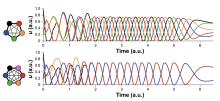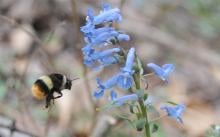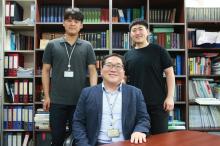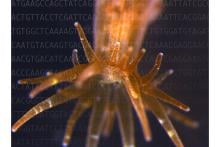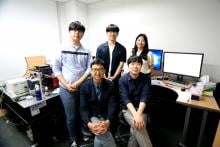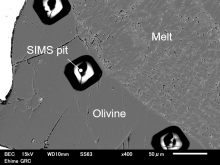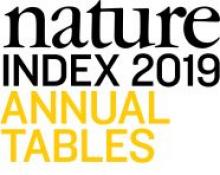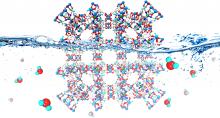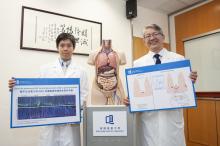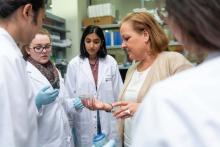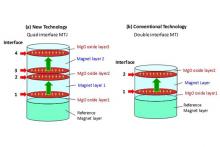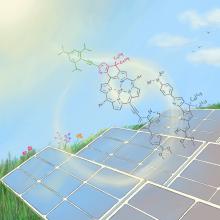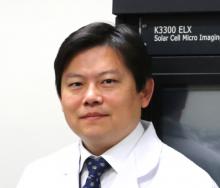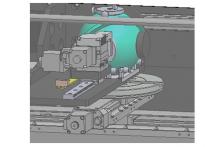Science
News
16 Jul 2019
MIT’s Research Enterprise in Singapore, SMART, launches a new research group, Critical Analytics for Manufacturing Personalized-Medicine (CAMP), as part of Singapore’s National Cell Manufacturing Initiative to overcome scientific and technical challenges in life-changing cell therapies
12 Jul 2019
As people age, the way different areas of their brain communicate with one another change, affecting thought processes and attention span.
12 Jul 2019
A computer model shows that a starfish-like animal can coordinate rhythmic motion based on body structure without the brain telling them to do so. This provides insights useful for physiology and robotics.
12 Jul 2019
Early snowmelt increases the risk of phenological mismatch, in which the flowering of periodic plants and pollinators fall out of sync, compromising seed production.
11 Jul 2019
The Global Development Network invites researchers from developing and transition countries to submit research proposals under the theme 'Doing research in developing countries: the role of non-academic actors, new communication platforms and leadership in social sciences' for the Japanese Award for Outstanding Research on Development by 26 July.
08 Jul 2019
DGIST Professor Yong Min Lee’s team in the Department of Energy Science and Engineering succeeded in developing an electrochemical model that can predict and analyze the electrochemical phenomena of the single particles of electrode active materials. Expects to be used in a single particle design research to improve cell efficiency.
08 Jul 2019
Researchers in Japan have identified the potential genes responsible for coral bleaching caused by temperature elevation.

04 Jul 2019
The call is open for research grants and postdoctoral fellowships for scientists in IsDB member countries who are working in fields of sustainability science relevant to the UN Sustainable Development Goals.

04 Jul 2019
Applying large enough magnetic fields usually results in the disruption of superconducting states in materials, even at drastically low temperatures.
04 Jul 2019
Joint research team of Professors Jaeheung Cho and Daeha Seo in the Department of Emerging Materials Science developed a technology to control the generation of nitric oxide in cells. Proposed the possibility of additional research related to cell signal transfer.
01 Jul 2019
The new President of The Hong Kong Polytechnic University (PolyU), Prof. Jin-Guang TENG, takes office today.
01 Jul 2019
It is believed that terrestrial planets were made from chondrites. However, geochemical observations have shown that the abundance pattern of volatile elements is inconsistent with chondrites. New high-pressure experiments suggest that F and Cl fractionation during magma ocean crystallization could explain the non-chondritic Earth's F/Cl ratio.
28 Jun 2019
Major institutions in the US and China dominate the top ranks for output of quality research articles, but a new normalized Nature Index ranking reveals that some smaller institutes are punching well above their weight.
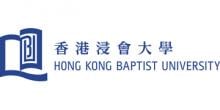
27 Jun 2019
A breakthrough nanostructure for neural stem cell cultivation developed by HKBU has won the TechConnect Global Innovation Award.
26 Jun 2019
A team of researchers from Tohoku University, J-PARC, and Tokyo Institute of Technology conducted an in-depth study of magnetic quasiparticles called "triplons." The team conducted the study with a low-dimensional quantum magnet, Ba2CuSi2O6Cl2, using neutron inelastic scattering by AMATERAS at J-PARC.
26 Jun 2019
A molecule-trapping material that normally degrades in water remains stable after two years of humidity exposure when treated with a common skin bleach.
25 Jun 2019
Researchers from the School of Chinese Medicine at Hong Kong Baptist University have found that the abnormal rise of a soluble protein called Nerve Growth Factor is a key factor linking early life stress to the development of irritable bowel syndrome.
25 Jun 2019
Web of Science data show that G20 nations are drivers of the global research system

21 Jun 2019
Selected, structured and complete data in the Web of Science provide rich insights into the contribution and value of the world’s most impactful scientific and research journals
21 Jun 2019
NYU Abu Dhabi researchers have reported a new way in which the liver is primed to regenerate itself. They found that by stripping parts of the epigenome, which play a primary role in repressing “jumping genes” (i.e. transposable elements), other epigenetic marks were redistributed.
19 Jun 2019
Using holography, researchers have found that when gravity is combined with quantum mechanics, symmetry is not possible.
18 Jun 2019
Researchers in Singapore have discovered the mechanism behind how neural stem cells in fruit flies are activated to stimulate the generation of new brain cells.

17 Jun 2019
Professor Hongsoo Choi’s team developed a microrobot that can precisely transplant stem cells in various in vivo and vitro environments. Expects to improve the efficiency of treating degenerative neural disorders such as Alzheimer by accurately and safely delivering to a desired location
17 Jun 2019
Singapore's week-long celebration of innovation is back! The tech community have their calendars marked for this year's incredible Smart Nation Innovations Week - and so should you!
14 Jun 2019
Researchers at Tohoku University have announced the development of a new magnetic tunnel junction, by which the team has demonstrated an extended retention time for digital information without an increase of the active power consumption.
13 Jun 2019
2019 marks the 200th year of bilateral relations between Singapore and the United Kingdom. The Singapore- UK Partnership for the Future was launched earlier this year, celebrating our longstanding partnership and embracing our cooperation in fields ranging from defence to digital.
12 Jun 2019
Japanese researchers are poised to reboot the field of aromatic-fused porphyrin sensitizers for dye-sensitized solar cells, the most efficient solar technology available at present.
07 Jun 2019
DGIST researchers are getting closer to developing a material that delivers a one-two punch: recycling atmospheric carbon dioxide for the production of cleaner hydrocarbon fuels.
07 Jun 2019
Tohoku University researchers have developed a technique using a hollow sphere to measure the electronic and optical properties of large semiconducting crystals. The approach improves on current photoluminescence spectroscopy techniques and could lead to energy savings for mass producers, and thus consumers, of power devices.
Giants in history
Chinese biochemist Chi Che Wang (1894 - 1979), one of the first Chinese women to study abroad, advanced to prominent research positions at American institutions including the University of Chicago and the Northwestern University Medical School.
Ruby Sakae Hirose (1904 – 1960) was a Japanese-American scientist whose research contributed significantly to our understanding of blood clotting, allergies and cancer.
Chinese electron microscopy specialist Li Fanghua (6 January 1932 – 24 January 2020) facilitated the high-resolution imaging of crystal structures by eliminating interference.
Sálim Moizuddin Abdul Ali (12 November 1896 – 20 June 1987), commonly referred to as the Birdman of India, was the first person to conduct systematic surveys of birds from across India.
Haisako Koyama (1916 – 1997) was a Japanese solar observer whose dedication to recording sunspots – cooler parts of the sun’s surface that appear dark – produced a sunspot record of historic importance.
Michiaki Takahashi (17 February 1928 – 16 December 2013) was a Japanese virologist who developed the first chickenpox vaccine.
Toshiko Yuasa (11 December 1909 – 1 February 1980) was the first Japanese female physicist whose research on radioactivity shed light on beta decay – the process in which an atom emits a beta particle (electron) and turns into a different element.
Angelita Castro Kelly (1942-2015) was the first female Mission Operations Manager (MOM) of NASA. She spearheaded and supervised the Earth Observing System missions during its developmental stage.
Malaysia’s first astrophysicist, Mazlan binti Othman (born 11 December 1951) was instrumental in launching the country’s first microsatellite, and in sending Malaysia’s first astronaut, Sheikh Muszaphar Shukor, into space.
Known as Mr. Natural Rubber, chemist and researcher B. C. Shekhar (17 November 1929 – 6 September 2006) introduced a number of technical innovations that helped put Malaysia’s natural rubber industry on the world map.
Shinichiro Tomonaga (31 March 1906 – 8 July 1979), together with Richard Feynman and Julian Schwinger, was awarded the Nobel Prize in Physics in 1965, for their contributions to advance the field of quantum electrodynamics. Tomonaga was also a strong proponent of peace, who actively campaigned against the proliferation of nuclear weapons and promoted the peaceful use of nuclear energy.
South Korean theoretical physicist Daniel Chonghan Hong (3 March 1956 – 6 July 2002) achieved fame in the public sphere through his research into the physics of popcorn.
Japanese chemist Kenichi Fukui (4 October 1918 – 9 January 1998) was the first Asian scientist to be awarded the Nobel Prize in Chemistry. Together with Roald Hoffman, he received this honour in 1981 for his independent research into the mechanisms of chemical reactions.
Chinese palaeontologist, archaeologist and anthropologist Pei Wenzhong (January 19, 1904 – September 18, 1982) is regarded as a founder of Chinese anthropology.
Physicist Narinder Singh Kapany (31 October 1926 – 4 December 2020) pioneered the use of optical fibres to transmit images, and founded several optical technology companies. Born in Punjab, India, he worked at a local optical instruments factory before moving to London for PhD studies at Imperial College. There, he devised a flexible fibrescope to convey images along bundles of glass fibres.
Japanese physicist Ukichiro Nakaya (1900-1962) made the world’s first artificial snowflakes. He started his research on snow crystals in the early 1930s at Hokkaido University, where there is an unlimited supply of natural snow in winter. By taking over 3,000 photographs, he established a classification of natural snow crystals and described their relationship with weather conditions.
The field of solid-state ionics originated in Europe, but Takehiko Takahashi of Nagoya University in Japan was the first to coin the term ‘solid ionics’ in 1967. ‘Solid-state ionics’ first appeared in 1971 in another of his papers, and was likely a play on ‘solid-state electronics’, another rapidly growing field at the time.
Charles Kuen Kao (Nov. 4, 1933 to Sept. 23, 2018) was an engineer who is regarded as the father of fibre optics. His work in the 1960s on long distance signal transmission using very pure glass fibres revolutionized telecommunications, enabling innovations such as the Internet.
Chika Kuroda (24 March 1884 – 8 November 1968) was a Japanese chemist whose research focussed on the structures of natural pigments.
Motoo Kimura (13 November 1924 – 13 November 1994) was a Japanese theoretical population geneticist who is best remembered for developing the neutral theory of molecular evolution.
Meghnad Saha (6 October 1893 – 16 February 1956) was an Indian astrophysicist best known for formulating the Saha ionization equation which describes the chemical and physical properties of stars.
Sir Jagadish Chandra Bose (30 November 1858 – 23 November 1937) was a scientist and inventor who contributed to a wide range of scientific fields such as physics, botany and biology.
Osamu Shimomura (27 August 1928 – 19 October 2018) was a Japanese organic chemist and marine biologist who dedicated his career to understanding how organisms emitted light.
Subrahmanyan Chandrasekhar (19 October 1910 – 21 August 1995) was an Indian astrophysicist who studied the structure and evolution of stars.
Joo-myung Seok (November 13, 1908 – October 6, 1950) was a Korean butterfly entomologist who made important contributions to the taxonomy of the native butterfly species in Korea.
Mathematician Maryam Mirzakhani (12 May 1977 – 14 July 2017) was the first and only woman and Iranian to date to win the Fields Medal in 2014 for her work on curved surfaces.
Sir Chandrasekhara Venkata Raman (7 November 1888 – 21 November 1970) was an Indian physicist who performed ground-breaking research in the field of light-scattering.
Mohammad Abdus Salam (29 January 1926 – 21 November 1996) was a theoretical physicist and the first Pakistani to receive a Nobel Prize in science.
Srinivasa Ramanujan (22 December 1887 – 26 April 1920) was a math prodigy and widely considered one of India’s greatest mathematicians. Despite having almost no formal training in mathematics, he made substantial contributions to mathematical analysis, number theory, infinite series and continued fractions.
Gopalasamudram Narayanan Ramachandran (8 October 1922 – 7 April 2001) is best known for developing the Ramachandran plot to understand the structure of short chains of amino acids, known as peptides.
Hitoshi Kihara (1893 – 1986) was one of the most famous Japanese geneticists of the 20th century. One of his most significant contributions was identifying sex chromosomes (X and Y) in flowering plants.
Chien-Shiung Wu (31 May 1912 – 16 February 1997) was an experimental physicist who made several important contributions to nuclear physics. Wu worked on the Manhattan Project – a top-secret program for the production of nuclear weapons during World War II and helped to develop a process for separating uranium into U235 and U238.
Meemann Chang (born 17 April 1936) is a Chinese palaeontologist who studied the fossils of ancient fish to understand the evolution of life. By examining fossils, she uncovered new insights on how vertebrates, animals with a backbone, migrated from the sea and became adapted to live on land.
Bibha Chowdhuri (1913 – 2 June 1991) was an Indian physicist who researched on particle physics and cosmic rays. In 1936, she was the only female to complete a M.Sc. degree at the University of Calcutta.
Lin Lanying (7 February 1918 – 4 March 2003) was a Chinese material engineer remembered for her contributions to the field of semiconductor and aerospace materials. Lanying was born into a family who did not believe in educating girls and she was not allowed to go to school.
Japanese geochemist Katsuko Saruhashi developed the first method and tools for measuring carbon dioxide in seawater


